Comparison is the death of joy.
DNAgents wasn’t the first teen team supreme, it wasn’t the most groundbreaking and the characters didn’t truly speak to the demographic they were meant to represent, but it was the first team of superheroes that was Generation X from the ground up instead of being reskinned characters from the 1940s.
The business model that brought DNAgents into existence was purest 21st century. The creators started this comic book with the intention of making it a TV series. Truth be told, it was a solid plan for the 1980s.
Mark Evanier had worked extensively as a TV writer in the seventies. He wrote for a bunch of shows that I had completely forgotten about like Pink Lady, and The Nancy Walker Show, and a few everybody remembers; Welcome Back Kotter and The Love Boat. There is one that I would like burned from my memory, Scooby Doo and Scrappy Doo. But that last abomination opened the door for Plastic Man, which is where he started making contacts with the comic book world.
Will Meugniot on the other hand, did mostly animated shows, but two of them, The Incredible Hulk and Spider-man and his Amazing Friends gave him connections at Marvel.
Once they got together, DNAgents was almost a default for them. By 1983 the indie comics scene was in full swing. This gave them more than two publishers to pitch their new teen supreme to. Not that DC and Marvel weren’t interested in the new title, they were. Everyone was, but the big two would come with a LOT of strings attached as well as muddied IP rights that would only favor the party with the biggest pocketbook. Of the three indy publishers they pitched to, Eclipse by then had the biggest footprint as well as a willingness to spend big on the promotional side.
The DNAgents were basically a squad of replicants with superpowers. Their purpose was to be enforcers of the “Matrix Corporation,” (Evil Co and Associates was already trademarked, I guess).
They were a five-member team with powers that didn’t really complement each other’s, but their personalities did. They had a tight family bond because they didn’t have anyone else in the world. They’ve been out of print so long I’ll have to fill you in on who they were.
Rainbow was the Leader and very much the fan favorite. She had telepathic but mostly illusionary powers. Her best known feature was her rainbow-colored hair that was exceptionally long. How long you ask? Whatever length the artist wanted it to be. She had a permanent big sister complex, and her costume was designed by Body Glove.
Surge was the Lancer, the guy that could be the leader but deferred to Rainbow out of respect. He had standard lightning powers and was hot headed.
Amber had a cowgirl outfit and had magnetic powers. She was extroverted and curious. Beyond that she was mostly the Other Girl.
Tank was the tank. He was gentle giant, easily wounded variety of tank.
Sham was the team polymorph. He was very small very shy, socially inept. Also, quite averse to sunlight for reasons that were never really explored.
Their premier story was Born Orphans. Where the boss of the Matrix corporation dumped them out of their tubes as adults and sent them straight into combat.
They weren’t just born orphans, they were born adults. This was kind of but not really explored. They were simply too developed as people when they were introduced. There was an effort to explore the whole thing of “What does it mean to be human?” Except they already knew. They were far too well adjusted and far too developed as human beings. Once they were out of their oversized test tubes they all started going to City Town University, where they seemed more like slightly out of place homeschoolers than people who didn’t exist a year ago.
Its fundamental weakness was 1970s television. It was where the creators cut their teeth and back then it was a box that you didn’t dare think outside of. There were tropes that were hard wired in and concepts that they really couldn’t let themselves explore. Or at least not explore in a way that could have taken DNAgents to the next level.
All of that said, a theme that the DNAgents had going for them was a feeling of displacement. Longing for something that everyone else had experienced, but had been denied to them. Generation X had no trouble at all identifying with that.
The other theme that was a prevalent aspect was the loathing of the 1980s corporate world. Some of that was the puppy-love for Jeffersonian socialism that the Boomer Left has never gotten over. But a more understandable part was the destruction of the uniquely American corporate culture where you would start on the loading dock and eventually work your way up to president of the company. The corporate raid on NABISCO was a classic example of a leveraged buyout where the company had to be looted down to the carpet tacks to pay off the junk bonds, and only incidentally shattered lives of thousands of men that worked there for decades. But not to worry, the guys with suspenders, power ties and Testarossas all came out of it with billions in their cocaine funds. Ayn Rand said I don’t have to feel guilty about any of this, so I don’t.
The DNAgents were in a position where they were utterly controlled by Matrix, it owned every facet of their existence. In one story arc, Rainbow agrees to model nude for a centerfold in exchange for a million bucks. She regrets her decision, but not to worry, Not-Playboy couldn’t publish it. Legally she was only three years old.
The DNAgents had their successes but they had quite a few failures as well. Surge had been assigned to bodyguard an heiress at college, he fell hard for her, and then she was murdered.
It made them more vulnerable than the average superheroes were in the early 80s. It made them trendsetters.
The first run was for 24 issues and was routinely in the top ten best sellers. It was famous enough in its day to rate a parody crossover from DC Comics. Namely, the Recombatants:
With two years of success behind them, Evanier and Meugniot went on to phase B of their plan and started pitching DNAgents to TV networks. CBS was interested… Briefly. They started putting together a pilot, Irvin Kershner was onboard. But then there was a change in C-Suite. The new regime declared superhero shows were dead and overpriced, (it was hard to argue either point by 1985), and the pilot was canceled.
Evanier and Meugniot were done. While they had the kind of success anyone in the comic book industry most creators would have given their teeth for, they themselves had taken a pay cut by leaving Hollywood to do this comic book. They had only ever pursued it with the intention of cashing in big with a TV show. With that possibility off the menu, they walked away from their own creation ending their run at issue 24.
The title wasn’t dead, or at least not yet. The New DNAgents hit the shelves in late 1985. Evanier was still writing, but the truth is there was something missing. Ingredients were left out of the secret sauce. Various plots were being thrown against the wall, that’s when Rainbow started nude modeling.* The quality of the art was becoming uneven. Various gimmicks were tried, Rainbow cut off her signature long hair, and then they had to reverse it due to fan outrage, as well as not having an easy way to keep her nudity PG-13. The stories became formulaic or at least formulaic compared to the rest of what was going on in the 1980s.
In 1987, their sales had fallen below a monthly number that modern comics can’t even dream of but it was still too low in its day to be sustainable. Evanier was offered a job at DC as well and the title was canceled.
The team came to a surprisingly sad ending. In the final issue, the DNAgents were put back in their test tubes because Matrix had cancelled the program and just left them there. My guess is that they thought it would be a temporary hiatus but they have never left that basement lab.
DNAgents came on the scene in 1983 when the first cusp of Generation X was graduating from high school. It didn’t truly have a lot to say to us, but we could get the uphill battle they were facing. It was fun, decently written, and good-girl sexy. And it didn't outstay its welcome. It also set the stage for teen teams of the 1990s, including the best known of 1990s indies Gen 13.
As I said at the start, comparison is the death of joy.
Discuss in the comments below





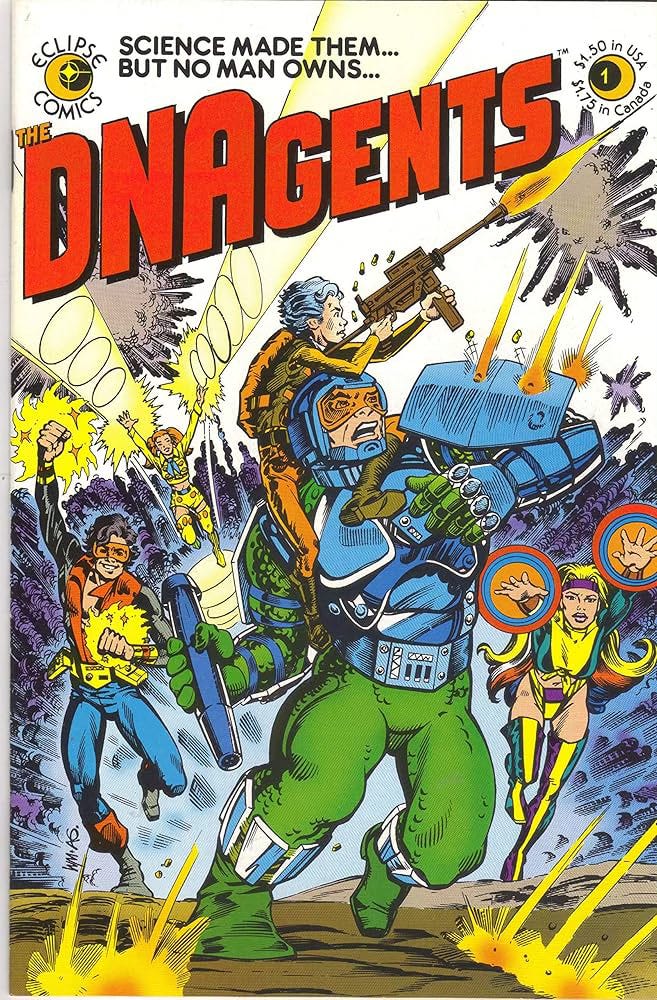

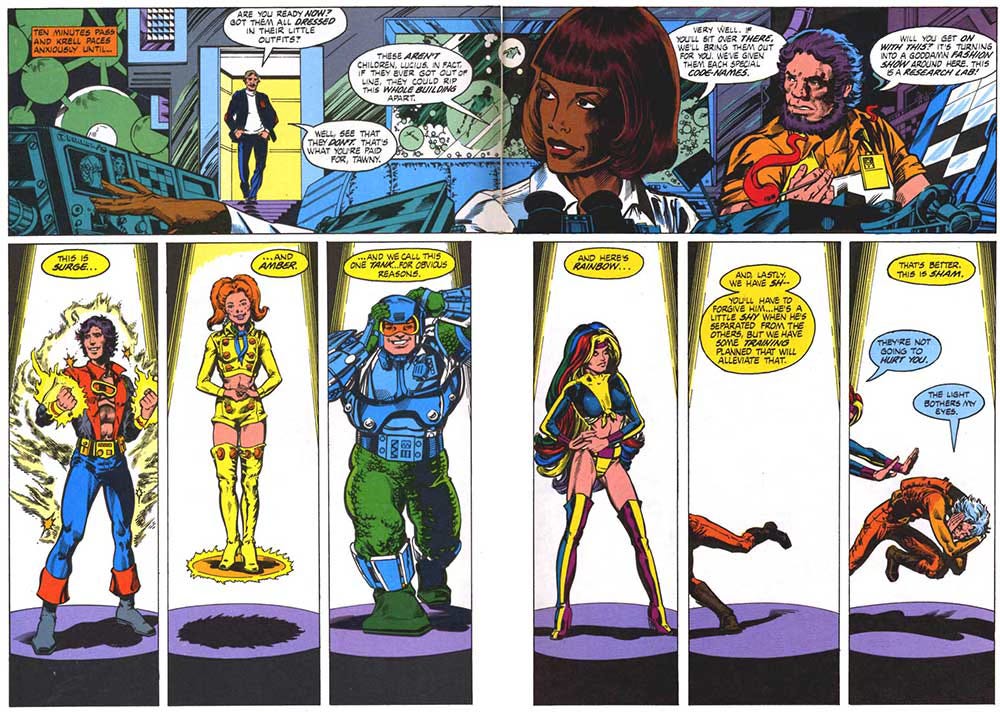
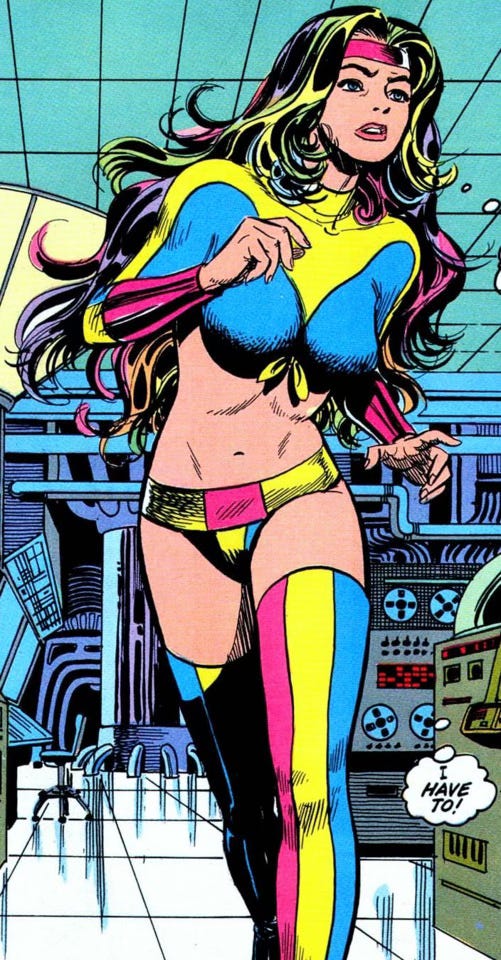
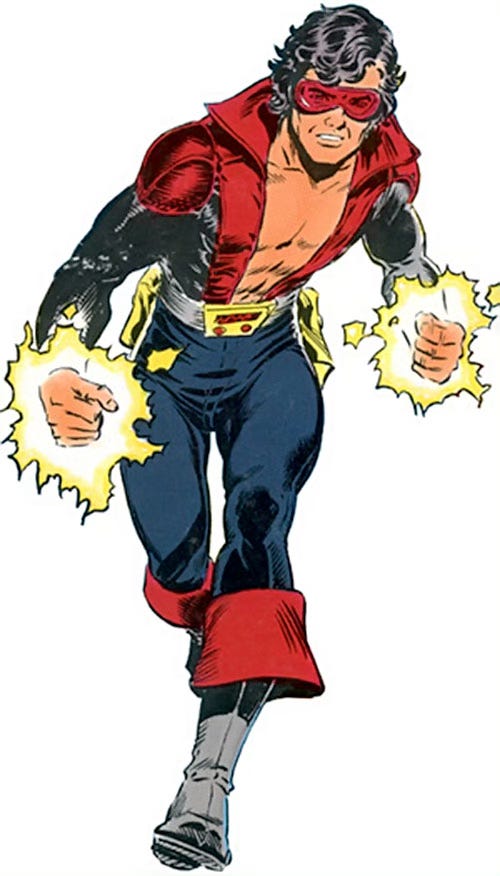




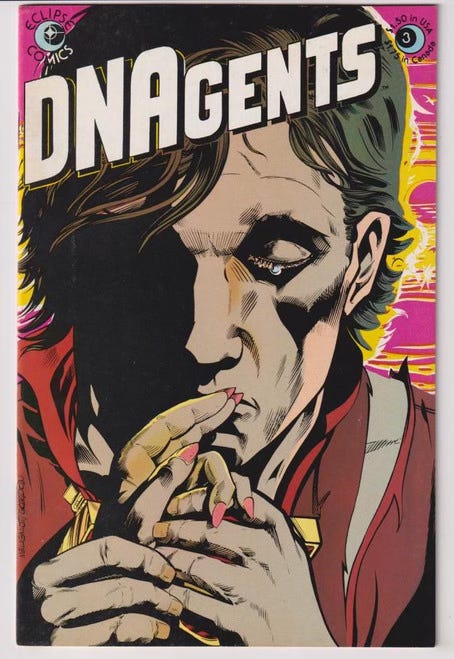
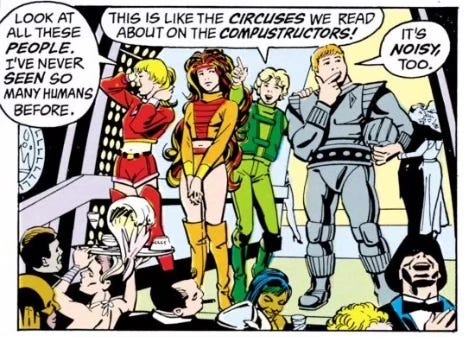

Rainbow had an interesting foundation that Evanier didn't really work with, probably due to lack of personal experience.
Precociously beautiful women are some of the spaciest things on Earth. They can't help it. They've been lied to constantly more or less all their lives. Their whole lives are spent in an unreal world until they reach a certain age.
But men couldn't lie to Rainbow. Not successfully.
Couple additions:
* {EDIT} There was an equivalent cross-over appearance of a Teen Titans expy in DNAgents 14, prior to the Recombatants' appearance. Evanier explained the background of these in one of his editorial columns.
* Will Meugniot went into animation work after DNAgents, most notably as one of the executive producers of Exosquad. He also did a fair bit of Good Girl Art for AC Comics during and after his work on DNAgents.
And hopefully I'm not stepping on a future post, but Crossfire is an important part of DNAgents. Evanier said in one of his many essays that it was his favorite comic.
It was a series by Evanier and Dan Spiegle, with the character's first appearances in DNAgents 4 and 9. The original Crossfire was a criminal who used a glide suit to do second-story work and other criminal activities, and was killed during a crime. The criminal Crossfire's body is found by Jay Endicott, a bail bondsman, who assumes his identity and acts the part of the original Crossfire in order to disrupt crimes and turn perpetrators over to the police -- very Green Hornet in nature.
Crossfire crossed over to DNAgents in that he and Rainbow became a couple until DNAgents ended. He almost kills the CEO for putting her in stasis, as she is pregnant with his child.
It morphed into a detective series with Crossfire just using the mask instead of the full glide suit, making him even closer in looks to Green Hornet. Crossfire's vibe was carried on by Evanier & Spiegle for Hollywood Superstars from EPIC Comics (Marvel imprint), though it only ran for about 3 issues.